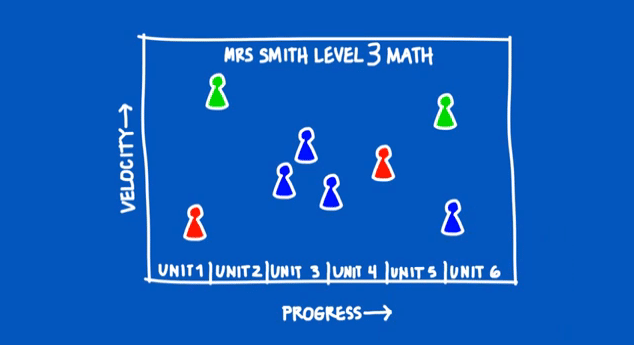What’s the Buzz about Buzz?
CompetencyWorks Blog
 Buzz is the teaching and learning platform that Michigan’s Education Achievement Authority (EAA) is using to support their Student-Centered Learning model (SCL). It has a lot of functionality, and I’m guessing I only saw about 50% of it – but from what I can tell, its one part student information and three parts content management. There are still some functions that EAA uses PowerSchool for and there are a bunch of interoperability issues that inhibit it from being all it can be. Nonetheless, Buzz is very impressive. Very.
Buzz is the teaching and learning platform that Michigan’s Education Achievement Authority (EAA) is using to support their Student-Centered Learning model (SCL). It has a lot of functionality, and I’m guessing I only saw about 50% of it – but from what I can tell, its one part student information and three parts content management. There are still some functions that EAA uses PowerSchool for and there are a bunch of interoperability issues that inhibit it from being all it can be. Nonetheless, Buzz is very impressive. Very.
FYI – You can read about Tom Vander Ark’s comments about Buzz on Getting Smart or at Ed Week. Or visit Agilix at the iNACOL Symposium exhibit hall.
Organized Around Instructional Cycle: Buzz organizes learning into four phases, Learn, Practice, Apply, and Assess. Each day, students check their emails in Buzz and it directs them to where they left off in their learning.
Choice and Co-Design: In the first three phases, students have choices. EAA has embedded co-design into the system. Learn directs students to options for new instruction. It may be a video, working with their teacher, reading text online or a chapter in a textbook. Practice usually directs students to units in an adaptive software program such as Compass, ALEKS, Imagine Learning, or content from Net Trekker.
In Apply, students see the rubrics that will be used to assess their application of their learning – application might mean completing an assignment online, creating a diorama, writing an essay, or participating in a project. When students feel that they are ready, that they have mastered the skill in the unit, they ask for a conference where teachers formally assess their work to determine if they are proficient and ready to move on to the next unit.
Autonomy: EAA has put together the core content for each unit. However, every step of the way, Buzz allows schools and teachers to author and edit the content. Most importantly, they can personalize the content choices for students based on what is going on that day with the student. Teachers focus on planning units, not lesson plans, making sure that there are choices in Learn, Practice, and Apply.
Tracking Progress: Buzz allows teachers to know where students are on their learning progression. Rather than a paper grade book, teachers have a radar report that allows them to track students’ progress and pace across the learning targets in each unit. Clicking on a student in the radar report allows teachers to deep dive into the student’s learning path, content choices, progress, and community wall. A selector tool allows teachers to easily group students and send notes or assign resources/activities. The student data from the Scantron Performance Series taken four times per year is entered into Buzz so teachers have a pretty good idea where students are in their learning progression (sadly this has to be done manually until Buzz and Scantron can “talk” to each other). As students advance, teachers indicate in Buzz the units for which they have demonstrated proficiency. Over time, you can see the student learning progression.
Personalization and Rapid Response: As described above, teachers can also edit and author content for everyone or for specific students. Thus, a student that is still having difficulties and may need more practice can be directed to other materials. Teachers can send encouraging notes and explanations of why they included this new content. This is one of the most important functions of Buzz – allowing immediate response to students that are struggling.
Managing Performance: From a principal and district perspective, Buzz provides oversight on how students are progressing and which teachers are able to get the greatest learning gains and which teachers are having trouble. It can identify which students are struggling and not learning on pace (EAA strives for 3 level gains per year or 1.5 grade level gains). However, once students have been identified, the deeper research has to be done by individual student. Nonetheless, Buzz provides an early warning system for EAA and principals to troubleshoot problems.
Teachers Master Buzz: Mary Esselman, Deputy Chancellor of the EAA, explained that they don’t directly train teachers how to use Buzz — they “put teachers through Buzz,” as a student in a blended professional development course, rather than just explaining it to them. Experiential learning and “show what you know” is at the heart of the professional development at EAA, with teachers preparing videos and presentations as they build up competencies in student-centered, blended learning, and mastery-based education.
Engagement and Access: At Brenda Scott Theatre Arts Academy, a Parent Technology Night was offered so parents can get a hands-on feeling of what Buzz looks like. It’s still a tough road though since many parents don’t have internet access. One of the things EAA schools are trying to do is help correct that situation as the power of Buzz will increase when transparency of the system expands to include parents.
—
I’m sure I’ll be writing about Buzz again. Personally, I’m fascinated about how it can begin to help districts and schools direct resources toward where they are needed to help students stay on pace. My experience in the continuous improvement world is that the real power clicks on when you can get exception reports that allow you to respond quickly to where there are bottlenecks and misalignment in delivering instruction and support.
Stay tuned.